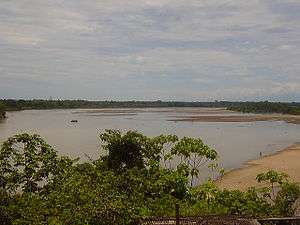Japurá River
The Japurá River or Caquetá River is a river about 2,820 kilometres (1,750 mi) long in the Amazon basin. It rises in Colombia[2] and flows eastward through Brazil to join the Amazon River.
| Japurá River Caquetá River | |
|---|---|
 | |
 Map of the Amazon Basin with the Japurá River highlighted | |
| Location | |
| Countries | |
| Physical characteristics | |
| Mouth | Amazon River |
• coordinates | 3°9′56″S 64°46′51″W |
| Length | 2,036 km (1,265 mi)[1] |
| Basin size | 255,700 km2 (98,700 sq mi) |
| Discharge | |
| • average | 18,620 m3/s (658,000 cu ft/s) |
Course
The river rises as the Caquetá River in the Andes in southwest Colombia. The Caquetá River rises near the sources of the Magdalena River, and augments its volume from many branches as it courses through Colombia.[3] It flows southeast into Brazil, where it is called the Japurá. The Japurá enters the Amazon River through a network of channels. It is navigable by small boats in Brazil. West of the Rio Negro, the Solimões River (as the Amazon's upper Brazilian course is called) receives three more imposing streams from the northwest—the Japurá, the Içá (referred to as the Putumayo before it crosses over into Brazil), and the Napo.[3]
Environment
For much of its length the river flows through the Purus várzea ecoregion.[4] The river is home to a wide variety of fish and reptiles, including enormous catfish weighing up to 91 kg (201 lb) and measuring up to 1.8 metres (5.9 ft) in length, electric eels, piranhas, turtles, and caimans.
Much of the jungle through which the eastern Caquetá originally flowed has been cleared for pasture, crops of rice, corn, manioc, and sugar cane, and in the past two decades, particularly coca crops.
Navigation
The 19th-century Brazilian historian and geographer José Coelho da Gama e Abreu, the Baron of Marajó, attributed 970 kilometres (600 mi) of navigable stretches to it. Jules Crevaux, who descended it, described it as full of obstacles to navigation, the current very strong and the stream frequently interrupted by rapids and cataracts.[3] It was initially supposed to have eight mouths, but colonial administrator Francisco Xavier Ribeiro Sampaio, in the historic report of his voyage of 1774, determined that there was but one real mouth, and that the supposed others are all furos or canos,[3] as the diverting secondary channels of the Amazonian rivers are known.
In 1864–1868, the Brazilian government made a somewhat careful examination of the Brazilian part of the river, as far up as the rapid of Cupati.[3] Several very easy and almost complete water routes exist between the Japurá and Negro across the low, flat intervening country.[3] The Baron of Marajó wrote that there were six of them, and one which connects the upper Japurá with the Vaupés branch of the Negro; thus the indigenous tribes of the respective valleys have easy contact with each other.[3]
The river serves as a principal means of transportation, being plied by tiny dugout canoes, larger ones, motorboats, and riverboats known locally as lanchas. The boats carry a multitude of cargoes, sometimes being chartered, sometimes even being traveling general stores. In the Colombian section, the presence of guerrillas and soldiers used to limit river traffic.
See also
References
- Ziesler, R.; Ardizzone, G.D. (1979). "Amazon River System". The Inland waters of Latin America. Food and Agriculture Organization of the United Nations. ISBN 92-5-000780-9. Archived from the original on 8 November 2014.
- Chisholm, Hugh, ed. (1911). . Encyclopædia Britannica. 6 (11th ed.). Cambridge University Press. p. 600.
- Chisholm, Hugh, ed. (1911). . Encyclopædia Britannica. 1 (11th ed.). Cambridge University Press. p. 787.
- "Purus varzea", Global Species, Myers Enterprises II, retrieved 2017-03-15
External links
| Wikisource has the text of the 1905 New International Encyclopedia article Yapurá. |